The PRC’s Dilemma in the Global Crisis
The subprime mortgage crisis and ensuing global downturn led many to speculate whether any challenger might emerge to replace the us as the dominant player in the capitalist world economy.footnote1 Because the financial crisis in the us and global North had originated in high indebtedness, low productivity and overconsumption, it seemed natural to look to their polar opposites—the East Asian exporters’ huge holdings of us debt, productive capacity and high savings rates—to identify likely candidates. Immediately after last year’s collapse of Lehman Brothers lifted the curtain on the global recession, there were proclamations of the final triumph of the East Asian, and above all Chinese, model of development; American establishment commentators concluded that the Great Crash of 2008 would be the catalyst for a shift of the centre of global capitalism from the us to China.footnote2
But by the spring of 2009, many had realized that the East Asian economies were not as formidable as appearances had suggested. While the sharp contraction in demand for imports in the global North had led to crash landings for Asia’s exporters, the prospect of either the us Treasuries market or the dollar bottoming out presented them with the difficult dilemma of either ditching American assets, and hence triggering a dollar collapse, or buying more, preventing an immediate crash but increasing their exposure to one in future. State-directed investment, rolled out late last year under the prc’s mega-stimulus programme, fostered a significant recovery for China as well as its Asian trading partners, but the growth generated is unlikely to be self-sustaining. Chinese economists and policy advisers have been worrying that the prc will falter again once the stimulus effect fades, as it is unlikely that American consumers will be picking up the slack any time soon. Despite all the talk of China’s capacity to destroy the dollar’s reserve-currency status and construct a new global financial order, the prc and its neighbours have few choices in the short term other than to sustain American economic dominance by extending more credit.
In what follows, I will trace the historical and social origins of the deepening dependence of China and East Asia on the consumer markets of the global North as the source of their growth, and on us financial vehicles as the store of value for their savings. I then assess the longer-term possibilities for ending this dependence, arguing that, to create a more autonomous economic order in Asia, China would have to transform an export-oriented growth model—which has mostly benefited, and been perpetuated by, vested interests in the coastal export sectors—into one driven by domestic consumption, through a large-scale redistribution of income to the rural-agricultural sector. This will not be possible, however, without breaking the coastal urban elite’s grip on power.
Tigers and geese
The story of the rapid postwar rise of Japan and the four Tigers—South Korea, Taiwan, Hong Kong and Singapore—is well known, and need not be repeated here. But if their dynamic ascent can be attributed to the role of their centralized authorities in directing precious resources to strategic industrial sectors, it is equally important to recognize that it was the Cold War geopolitics of East Asia that made developmental states possible there in the first place. What was being fought during the Cold War period in East Asia was actually a hot war. Communist China’s support for guerrillas and its involvement in the Korean and Vietnam wars had led the region into a permanent state of emergency, and Washington regarded East Asia as the most vulnerable link in its strategy for containing Communism. Considering its key Asian allies—Japan and the four Tigers—too important to fail, it provided them with abundant financial and military aid to jump-start and direct industrial growth, while also keeping American and European markets wide open to Asian manufactured goods. This access to Western markets constituted a further advantage that other developing countries did not enjoy, and without which it is unimaginable that the Asian economies would have had such success. Viewed in this light, the rapid economic growth of East Asia was far from a ‘miracle’. The us engineered it as part of an effort to create subordinate and prosperous bulwarks against Communism in the Asia-Pacific region. These economies were never meant to challenge American geopolitical and geo-economic interests; instead they were subservient clients helping Washington to realize its designs in the region.
Organized in multilayered subcontracting production networks centred on Japan, Asian exporters occupied different links in the value chain, each specializing in goods at a particular level of profitability and technological sophistication. Japan focused on the most high-value-added items, the four Tigers on middle-range products and the emerging Tigers in Southeast Asia on low-cost, labour-intensive ones. This famous flying-geese pattern formed a network of reliable suppliers of a wide range of consumer products to the First World.
When Cold War tensions started to ease in the 1980s, us current-account and fiscal deficits were mounting as a result of neoliberal tax cuts and escalating military expenditure in the final stages of the Cold War. Instead of breaking out of the orbit of American hegemony, however, the Asian economies tightened their ties to the us by financing its skyrocketing twin deficits. East Asia’s export-oriented industrialization had been coupled with low domestic consumption. Subsequent trade surpluses and high savings rates enabled these states to accumulate substantial financial power in the form of large foreign-exchange reserves. Regarding us Treasuries as the safest investment in global finance, most East Asian exporters voluntarily parked their hoarded cash in low-yield us Treasury bonds, turning themselves into America’s principal creditors. Their financing of the us current-account deficit then fuelled America’s appetite for Asian imports, and the further increase in Asian trade surpluses led to yet more purchases of Treasury bonds. These mutually reinforcing processes continuously amplified East Asia’s market and financial dependence on the us, helping to prolong its fragile prosperity while American hegemony unravelled.
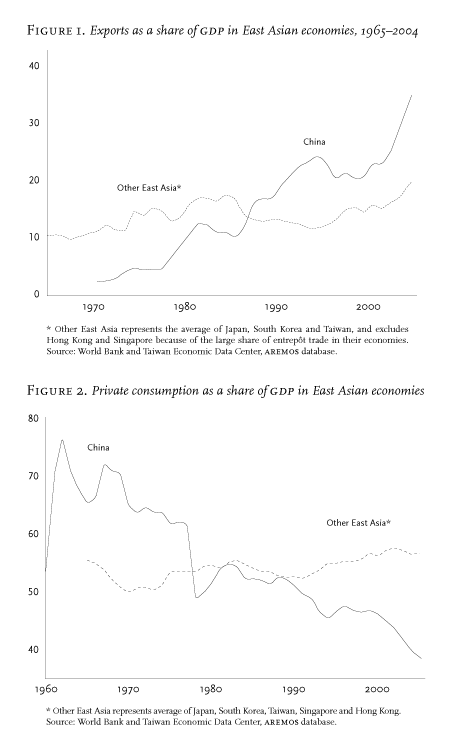

Beginning in the 1980s and accelerating in the 90s, the prc’s market reforms turned it into a latecoming Asian Tiger. Many predicted that it would be uniquely capable of breaking away from Asia’s twin dependence on the us because of its geopolitical autonomy and exceptional demographic and economic size. But so far China has not freed itself from the servitude of providing America with cheap credit and low-cost imports. Worse, the intensity of the prc’s export-led and private-consumption-repressing growth model has made its market and financial dependence on the us even greater than that of its predecessors. If we compare the most important aspects of China’s political economy with those of its neighbours at a similar stage of development, we find that the Chinese model is largely a replication in extreme form of earlier East Asian growth. Figure 1 shows that the Chinese economy’s trade dependence, as measured by the total value of exports as a percentage of gdp, has been mounting continuously, reaching a level never attained in other East Asian economies. On the other hand, the weight of Chinese private consumption as a percentage of gdp has been declining, dropping well below that of the other countries during their takeoff (Figure 2). As Table 1 indicates, for China—like Japan and the Asian Tigers before it—the us is the single most important export market, only surpassed recently by the eu taken as a whole. China has already become America’s leading Asian supplier.
The drastic expansion of China’s export industries not only accounts for its stellar economic growth, but also, through its enlarged trade surplus, its global financial power. As shown in Figure 3 below, China’s foreign-exchange reserves now well exceed those of its East Asian neighbours. So far China has, like the other exporters, been investing most of its savings in us Treasury bonds. By the eve of the subprime mortgage crisis, China had emerged as the largest exporter to the us and at the same time its largest creditor, financing America’s current-account deficit and sustaining its capacity to absorb imports (see Figure 4). While China’s low-cost exports helped lower us inflation, its massive purchase of Treasury bonds helped reduce their yields and thus also us interest rates. In so doing, China emerged in recent years as the principal upholder of us economic vitality.
Agrarian crisis
China’s ability to institute an extreme version of the East Asian export-led growth model over the last three decades hinged on both the global conjuncture and the prc’s internal political economy. First, China’s labour-intensive takeoff coincided with the onset of an unprecedented expansion in global free trade since the 1980s. Were it not for the outsourcing of industry from the global North and the latter’s mounting appetite for low-cost manufactured imports, the prc would have found it impossible to export its way to prosperity. More importantly, China’s exceptional competitiveness is largely founded on the prolonged stagnation of manufacturing wages in comparison with other Asian countries at equivalent stages of development.
Many argue that China’s wage competitiveness originates in its fixed exchange-rate regime, which undervalues its currency considerably. Others assert that China’s huge surplus of rural labour allowed it to develop with an ‘unlimited’ supply of labour for much longer than other Asian economies. But closer scrutiny reveals both of these explanations to be inadequate. First, as Figure 5 (below) shows, the difference between China’s wage levels and those of its neighbours is much greater than could be explained by an undervalued currency. Even if the yuan appreciated by 20–30 per cent relative to the dollar—as many American critics of China’s currency manipulation advocate—Chinese wages would still be significantly lower. Second, an unlimited supply of labour is not a natural phenomenon given by China’s population structure, as is so often assumed. Rather, it is a consequence of the government’s rural-agricultural policies which, intentionally or unintentionally, bankrupt the countryside and generate a continuous rural exodus.
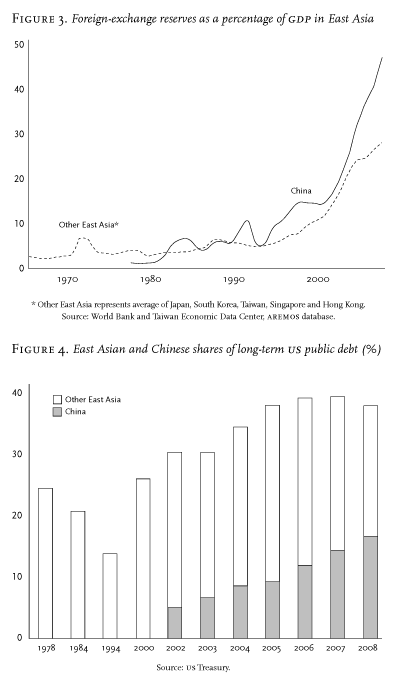
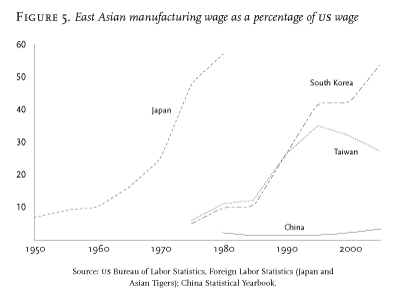
The relation between these policies and low wage levels can be illustrated by contrasting China’s rural development with that of Japan, South Korea and Taiwan, which also had large rural populations and agrarian sectors at the beginning of their economic takeoff. In postwar Japan, the ruling Liberal Democratic Party had actively directed resources to the countryside through rural infrastructure spending, agricultural development financing, farm subsidies and tariffs on foreign produce. In South Korea, the Park regime launched the New Village Movement (Saemaul Undong) in the early 1970s, diverting significant fiscal resources to upgrade rural infrastructure, finance agricultural mechanization, and set up rural educational institutions and co-operatives. This initiative was a remarkable success: it increased rural household income from 67 per cent of urban income in 1970 to 95 per cent in 1974, virtually obliterating the rural–urban income gap.footnote3 In Taiwan, the kmt government pursued similar policies in the 1960s and 70s, alongside conscious efforts to promote rural industrialization. The resulting decentralized structure of Taiwanese industry allowed farmers to work seasonally in nearby factories without abandoning farming altogether or migrating to big cities. This helped retain a considerable share of labour resources in the village, fostering a more balanced rural–urban growth; throughout the 1960s and 70s, per capita rural income was always above 60 per cent of the urban level. Under such policies, it is not surprising that the surplus of rural labour rapidly dried up and manufacturing wages soared in these countries.
The reasons for the adoption of these different paths varied. In Japan, the significance of rural votes to the ldp’s electoral success explained its attention to rural development. For the right-wing authoritarian regimes in South Korea and Taiwan, the promotion of rural-agricultural development was a way to minimize the social dislocation that usually accompanies industrialization and preempt the rise of leftist influences in the countryside. It was also a crucial way to ensure food security in the context of Cold War tensions. In contrast, China’s industrial development since the mid-1980s has been much more imbalanced than that of Japan, South Korea or Taiwan. Over the last twenty years, the Chinese government has largely concentrated investment in the urban-industrial sector, particularly in coastal areas, with rural and agricultural investment lagging behind. State-owned banks have also focused their efforts on financing urban-industrial development, while rural and agricultural financing were neglected. In the last two decades, rural per capita income has never exceeded 40 per cent of the urban level.
This urban bias emerged at least partly due to the dominance of a powerful urban-industrial elite from the Southern coastal regions—a segment which germinated after China’s initial integration into the global economy, expanded its financial resources and political influence with the export boom, and became increasingly adept at shaping central government policy in its favour. According to a recent assessment, the ccp’s ‘elitist faction’—comprised of senior leaders who built their careers in coastal regions and in trade and finance administrations—controls more seats in the Politburo than their rival ‘populist faction’, which has stronger ties to inland provinces. Though Hu Jintao, the current head of state, is a leader of the populist faction, Xi Jinping—chosen by the Party to succeed Hu in 2012 over Hu’s own favourite—had been the head of the coastal provinces of Fujian and Zhejiang, and is a leading figure in the elitist faction.footnote4 Their growing leverage ensured that more attention was given to enhancing China’s export competitiveness and attractiveness to foreign investment, rather than to agrarian development. The urban revolts of 1989—stemming from hyper-inflation and deteriorating living standards in big cities—only made the party-state more determined to ensure the economic prosperity of metropolitan areas at the expense of the countryside in the 1990s.
The result of this urban bias has been relative economic stagnation in the countryside and a concomitant fiscal stringency on the part of rural local governments. From the 1990s onwards, the deterioration of agricultural incomes and the demise of collective rural industries—the township and village enterprises (tves) which used to be vibrant generators of employment in the early stages of market reform—forced most young labourers in the countryside to leave for the city, creating a vicious cycle which has precipitated a rural social crisis. China’s agrarian sector was not only neglected, however, it was also exploited in support of urban growth. A recent study has found that there was a sustained and increasing net transfer of resources from the rural-agricultural to the urban-industrial sector between 1978 and 2000, both through fiscal policy (via taxation and government spending) and the financial system (via savings deposits and loans).footnote5 The exceptions to this trend were the years when the urban economy experienced a temporary downturn, such as the aftermath of the 1997–98 Asian Financial Crisis (see Figure 6, below).
The prc’s urban-biased development model, then, is the source of China’s prolonged ‘limitless’ supply of labour, and thus of the wage stagnation that has characterized its economic miracle. This pattern also accounts for China’s rising trade surplus, the source of its growing global financial power. However, the low wages and rural living standards that have resulted from this development strategy have constrained China’s domestic consumer market and deepened its dependence on the global North’s consumption demand, which increasingly relies on massive borrowing from China and other Asian exporters. As those other exporters have been integrated with China’s export engine through the regionalization of industrial production networks, the vulnerabilities of the Chinese economy have turned into weaknesses of the East Asian region as a whole.
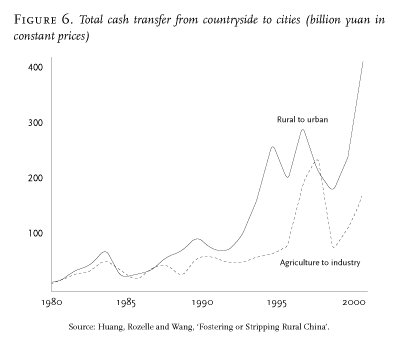
Sinocentric dependency
In the 1990s, China gradually established itself as the most competitive Asian exporter of products at various levels of technological sophistication. As a result, the others—including Japan and the original four Tigers, together with a group of emerging ones in Southeast Asia such as Malaysia and Thailand—were put under intense pressure to adjust. The prc’s competitiveness induced many export manufacturers to relocate there from elsewhere in Asia. An Economist report in 2001 noted the ‘alarm and despair’ with which China’s neighbours reacted to its rise:
Japan, South Korea and Taiwan fear a ‘hollowing out’ of their industries, as factories move to low-cost China. Southeast Asia worries about ‘dislocation’ in trade and investment flows. . . . China is no [flying] goose . . . because it makes simple goods and sophisticated ones at the same time, rag nappies and microchips . . . [It] makes goods spanning the entire value chain, on a scale that determines world prices. Hence East Asia’s anxiety. If China is more efficient at everything, what is there left for its neighbours to do?footnote6
It is certainly the case that China’s neighbours painstakingly restructured their export sectors to minimize head-on competition with the prc and profit from its rise. Under the old East Asian industrial order, each economy had exported specific groups of finished consumer products. Now these countries began to increase the proportion of high value-added components (Korea and Taiwan) and capital goods (Japan) in their exports to the People’s Republic.
As Table 2 (below) indicates, exports to China from South Korea, Hong Kong and Taiwan overtook their exports to the us over the last decade, while those from Japan and Singapore to China rapidly approached the share of their exports going to America. By 2005, the Japan-centred flying geese model of Asian regionalism had been replaced by a Sinocentric production network in which China exported most final consumer goods to the global North on behalf of its Asian neighbours, which provided China with the necessary parts and machines for assembly. This structure can be seen as a team of servants with China at the head, leading the others in providing cheap exports to the us and using its hard-earned savings to finance American purchases of those exports.
Regional integration in East Asia is well reflected in the correlation between the ups and downs of China’s export figures and those of its neighbours. For example, Asia’s recovery from the financial crisis of 1997–98, and Japan’s renewed growth after 2000, are attributable at least in part to the Chinese economic boom absorbing their manufactured components and capital goods. When the current global crisis began to unfold and consumer demand in the us started to contract sharply in the autumn of 2008, Asian exports plunged immediately, while those of the prc dived to a similar extent only about three months later. The cause of this time lag was the fact that the drop in Asian exports was largely a function of a decline in orders for parts and capital goods from China, in anticipation of plummeting orders for the final products from America and elsewhere in the months to come. The limitations of the Chinese development model—overdependence on consumption in the West and lethargic growth in the domestic market—inevitably translate into vulnerabilities for its Asian partners, leaving all of these economies exposed to any major contraction of consumption demand in the global North. Rebalancing China’s development, therefore, is not only necessary for the sustainability of its economic growth, but also for the collective future of East Asia as an integrated economic bloc.
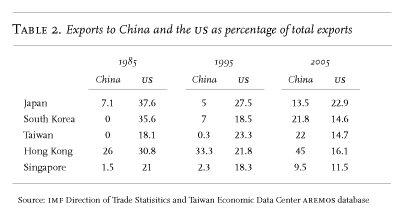
Obstacles to rebalancing
Chinese and East Asian governments have employed their foreign reserves to purchase us debt not only in search of presumably stable and safe returns, but also as part of a deliberate effort to finance America’s escalating current-account deficit, and hence secure a continuous increase in us demand for their own exports. But the deficit cannot expand indefinitely, and could eventually result in the collapse of the dollar or the Treasuries market and a hike in interest rates, putting an end to America’s consumption spree. This would not only be a mortal blow to China’s export engine, but would also decimate its global financial power through a drastic devaluation of its pre-existing investments.
Prior to the current crisis, the Chinese government had been experimenting with different ways to diversify and increase returns on its foreign-reserve holdings. It had tried investing in foreign equities and financing state-owned companies’ acquisitions of transnational corporations, but nearly all attempts ended in embarrassing failures. These were less the result of bad investment decisions than of constraints imposed by the exceptional size of China’s foreign reserves, which make it difficult for Beijing to move in and out of certain financial assets freely without disrupting global markets. At the same time, Chinese purchases of major foreign companies remain likely to prompt a protectionist or nationalist backlash. As a result, China’s overseas acquisitions have mostly been declining businesses desperately in search of buyers. These obstacles to diversifying its holdings were evident in the unprofitable 2005 purchase of ibm’s pc business by Lenovo, a major computer corporation affiliated with the Chinese government; the massive loss incurred by the 2007 investment in Blackstone by the China Investment Corporation, the prc’s sovereign wealth fund; and the upsurge of anti-Chinese sentiment in Australia triggered by the 2009 attempt by Chinalco, a giant state-owned resource company, to raise significantly its stake in Rio Tinto, Australia’s biggest mining company. China’s stockpiling of imported petroleum and other commodities, to hedge against rising raw-material prices, also brought substantial losses when their prices plummeted in the wake of the global downturn.
Besides exposing the country to the vicissitudes of global markets, China’s export-oriented model has drastically curtailed consumption. As noted earlier, the prc’s export competitiveness has been built upon long-term wage stagnation, which arose in turn from an agrarian crisis under an urban-biased policy regime. Rather than sharing a greater part of profits with employees and raising their living standards, the thriving export sector has turned most of its surplus into enterprise savings, which now constitute a large proportion of aggregate national savings. As Figure 7 (below) shows, from the late 1990s onwards total wages declined as a share of gdp, in tandem with a fall in private consumption. These two downward trends contrast starkly with the mounting scale of corporate profits. Although consumption has been rising in absolute terms, it has grown far more slowly than investment (see Figure 8, below).
This curtailment of private consumption has not only made it difficult for domestic-oriented firms to run down their inventories, it has also brought frustrations for many foreign businesses with high expectations of China’s supposedly gigantic market. Though already established as a significant buyer of capital goods, manufactured components and natural resources from Japan, Southeast Asia, Brazil and elsewhere, China has yet to actualize much of its potential as a key importer of consumer goods from the developed and industrializing world alike. The Economist complained on behalf of these disheartened foreign investors that ‘the market will turn out to be smaller than expected and take longer to develop; and because so many foreign businesses are piling in, competition is likely to be fierce . . . How can foreign firms generate acceptable returns in China?’footnote7 In similar vein, when it turned out that Chinese demand for automobiles had grown much more slowly than the sector’s production capacity, Forbes magazine recognized that ‘rising competition in China has led to manufacturing overcapacity and a rapid decline in car makers’ profit margins there to a level largely in line with the rest of the world, at 4 to 6 per cent’.footnote8

In an attempt to initiate a rebalancing of China’s development—characterized by Premier Wen Jiabao in 2007 as ‘unstable, unbalanced, uncoordinated and unsustainable’—the central government under Hu Jintao and his ‘populist’ allies had tried from 2005 to fuel domestic consumption by boosting the disposable income of peasants and urban workers. The first wave of such initiatives included the abolition of agricultural taxes and a rise in government procurement prices for agricultural products. Though these measures to raise rural living standards were no more than a small step in the right direction, their effect was instantaneous. Slightly improved conditions in the rural-agricultural sector slowed the flow of migration to the cities, and a sudden labour shortage and wage hike in the coastal export-processing zones ensued, inducing many economists to declare that the Lewisian Turning Point—at which rural surplus labour has been exhausted—had finally arrived.footnote9
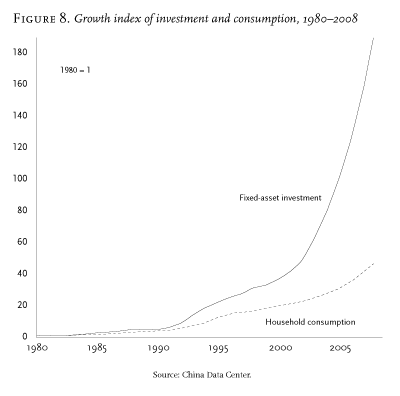
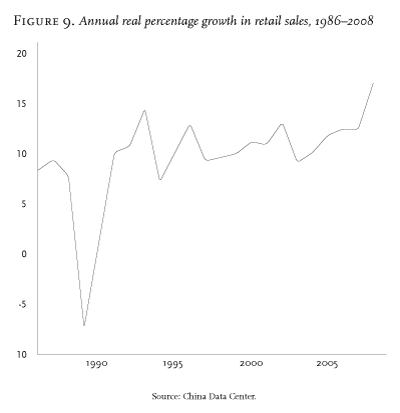
When the global crisis struck and China’s export engine stalled, the prc immediately rolled out a mega-fiscal-stimulus package amounting to us $570 billion (including both government spending and targeted loans from state-owned banks) in November 2008. Many initially celebrated this massive intervention as a precious opportunity to accelerate the rebalancing of the Chinese economy towards domestic consumption, and expected that the stimulus would consist principally of social spending—such as financing for medical insurance and social-security accounts—which could further raise the disposable income and hence purchasing power of the working classes. However, no more than 20 per cent of the stimulus package was in fact allocated to social spending; the large majority went to fixed-asset investment in sectors already plagued by overcapacity, such as steel and cement, and in the construction of the world’s biggest high-speed rail system, whose profitability and utility are uncertain.footnote10 Without providing much assistance to social-welfare institutions or small and medium labour-intensive enterprises, the stimulus package will generate only limited improvements in disposable income and employment. Worse, the central government, seemingly horrified by the sudden collapse of the export sector, retreated from its rebalancing efforts and resumed a number of export-promotion measures, such as rebates on value-added taxes on exports and halting the appreciation of the yuan. Manufacturers in these sectors even made use of the crisis to call for a suspension of the 2007 New Labour Contract Law for the sake of their survival.footnote11
Despite its impressive size, the fiscal stimulus will do little to promote domestic consumption and hence reduce China’s export dependence. Though a large quantity of funds was directed to the Western provinces to redress the development gap between coastal and inland areas, the mostly capital-intensive, urban-oriented growth promoted by the stimulus has actually aggravated the rural–urban polarization (see Table 3). While the heavy urban bias of fixed-asset investment continued, the urban–rural gap in income growth, which narrowed after 2005, widened again under the stimulus. This has put a brake on the relative rise in rural living standards since 2005, which had helped fuel modest growth in domestic consumption.

Prospects
Over the course of the last two decades, China has emerged as the final assembler and exporter in an East Asian network of production. It has also attained the status of largest creditor to the us and largest holder of foreign reserves, and demonstrated the potential to become the market of the world in addition to being its workshop. China is thus well poised to carve out a new regional and global economic order by helping Asia and the global South to move out of their market and financial dependence on the North in general and the us in particular.
China’s potential to lead, however, is far from being actualized. So far, the prc’s strategy of lending to the us to facilitate purchases of Chinese exports has only deepened China’s, as well as its suppliers’, dependence on American consumers and the us bond market, making them vulnerable to any turbulence in the global economy. The prc’s long-term export competitiveness is rooted in a developmental approach that bankrupts the countryside and prolongs the unlimited supply of low-cost migrant labour to coastal export industries. The resultant ever-increasing trade surplus may inflate China’s global financial power, in the form of expanded holdings of us debt, but the long-term suppression of wages restrains the growth of China’s consumption power. The current financial crisis, which has decimated consumer demand in the global North and increased the likelihood of a collapse of the us bond market and the dollar, is a belated wake-up call for an urgent change of course.
Beijing is well aware that further accumulation of foreign reserves is counterproductive, since it would increase the risk associated with the assets China already holds or else induce a shift to ever riskier ones. The government is also very aware of the need to reduce the country’s export dependence and stimulate the growth of domestic demand by increasing the working classes’ disposable income. Such a redirection of priorities has to involve moving resources and policy preferences away from the coastal cities to the rural hinterland, where protracted social marginalization and underconsumption have left ample room for improvement. But the vested interests that have taken root over several decades of export-led development make this a daunting task. Officials and entrepreneurs from the coastal provinces, who have become a powerful group capable of shaping the formation and implementation of central government policies, are so far adamant in their resistance to any such reorientation. This dominant faction of China’s elite, as exporters and creditors to the world economy, has established a symbiotic relation with the American ruling class, which has striven to maintain its domestic hegemony by securing the living standards of us citizens, as consumers and debtors to the world. Despite occasional squabbles, the two elite groups on either side of the Pacific share an interest in perpetuating their respective domestic status quos, as well as the current imbalance in the global economy.
Unless there is a fundamental political realignment that shifts the balance of power from the coastal urban elite to forces that represent rural grassroots interests, China is likely to continue leading other Asian exporters in diligently serving—and being held hostage by—the us. The Anglo-Saxon establishment has recently become more respectful towards its Asian partners, inviting China to become a ‘stakeholder’ in a ‘ChiAmerican’ global order, or ‘g2’. What they mean is that China should not rock the boat, but should continue to help maintain American economic dominance (in return, perhaps, for more consideration of Beijing’s concerns over Tibet and Taiwan). This would enable Washington to buy precious time to secure its command over emergent sectors of the world economy through debt-financed government investment in green technology and other innovations, and hence remake its ailing supremacy into a green hegemony. This seems to be exactly what the Obama administration is betting on as its long-term response to the global crisis and declining American power.
If China were to re-orient its developmental model and achieve greater balance between domestic consumption and exports, it could not only free itself from dependence on the collapsing us consumer market and addiction to risky us debt, but also benefit manufacturers in other Asian economies that are equally eager to escape these dangers. More importantly, if other emerging economies were to pursue a similar re-orientation and South–South trade were to deepen, then they could become one another’s consumers, ushering in a new age of autonomous and equitable growth in the global South. Until that happens, however, a recentring of global capitalism from West to East and from North to South in the aftermath of the global crisis remains little more than wishful thinking.